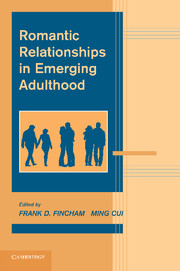Book contents
- Frontmatter
- Contents
- List of Contributors
- Foreword
- PART I INTRODUCTION
- PART II CONCEPTUAL AND METHODOLOGICAL FOUNDATIONS
- PART III THE DEVELOPMENTAL CONTEXT OF ROMANTIC RELATIONSHIPS IN EMERGING ADULTHOOD
- PART IV RELATIONSHIP PROCESSES IN EMERGING ADULTHOOD
- 9 The Evolution of Romantic Relationships: Adaptive Challenges and Relationship Cognition in Emerging Adulthood
- 10 Initiating and Evaluating Close Relationships: A Task Central to Emerging Adults
- 11 Putting the Romance Back Into Sex: Sexuality in Romantic Relationships
- 12 Understanding Romantic Relationships Among Emerging Adults: The Significant Roles of Cohabitation and Ambiguity
- 13 Implications of Parasympathetic Nervous System Functioning for Affect Regulation and Romantic Relationships in Emerging Adulthood
- PART V PRACTICAL IMPLICATIONS
- Index
- References
9 - The Evolution of Romantic Relationships: Adaptive Challenges and Relationship Cognition in Emerging Adulthood
Published online by Cambridge University Press: 06 December 2010
- Frontmatter
- Contents
- List of Contributors
- Foreword
- PART I INTRODUCTION
- PART II CONCEPTUAL AND METHODOLOGICAL FOUNDATIONS
- PART III THE DEVELOPMENTAL CONTEXT OF ROMANTIC RELATIONSHIPS IN EMERGING ADULTHOOD
- PART IV RELATIONSHIP PROCESSES IN EMERGING ADULTHOOD
- 9 The Evolution of Romantic Relationships: Adaptive Challenges and Relationship Cognition in Emerging Adulthood
- 10 Initiating and Evaluating Close Relationships: A Task Central to Emerging Adults
- 11 Putting the Romance Back Into Sex: Sexuality in Romantic Relationships
- 12 Understanding Romantic Relationships Among Emerging Adults: The Significant Roles of Cohabitation and Ambiguity
- 13 Implications of Parasympathetic Nervous System Functioning for Affect Regulation and Romantic Relationships in Emerging Adulthood
- PART V PRACTICAL IMPLICATIONS
- Index
- References
Summary
Forming and maintaining a successful romantic relationship can be a challenge. Without question, attaining love and romance can enrich your life and can help satisfy the need for positive, long-term social bonds. Yet, you can have trouble finding the “right” partner or any partner at all, and even if you find a suitable partner, so many things can go wrong. Your satisfaction can wane, and your level of commitment can go with it. You can be tempted by infidelity, or your partner may fall prey to similar temptations. These challenges can be particularly troublesome among emerging adults, who tend to have relatively little experience with forming and maintaining a successful long-term relationship. Indeed, emerging adults in many ways must feel their way through a new romantic relationship with relatively little knowledge or background to guide them.
Given the potential difficulties inherent in forming and maintaining a close romantic relationship, it is surprising that so many relationships among young adults are successful. However, their relationship successes are perhaps less surprising when one considers that human beings have been succeeding at long-term romantic relationships for thousands of generations. All of our ancestors were successful at mating (at least insofar as they were able to reproduce), and we have inherited from them a very useful suite of psychological processes that help us solve important relationship problems. In this sense all people are built to succeed at romantic relationships.
- Type
- Chapter
- Information
- Romantic Relationships in Emerging Adulthood , pp. 169 - 189Publisher: Cambridge University PressPrint publication year: 2010
References
- 3
- Cited by



